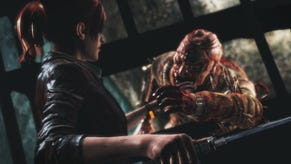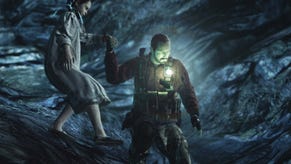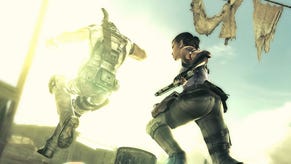Resident Evil: Revelations 2 might yet be great, but the episodic structure does it no favours
Dead and Barry'd.
This is an early impressions piece based on playing through the first episode of Resident Evil Revelations 2. We'll have a full review once all episodes are live in the middle of March.
The first motivation behind a spin-off is money. But what comes after, especially if you're the creatives tasked with giving another angle on a popular series? In the case of Resident Evil: Revelations the answer was fan-service - albeit quality fan-service - with original protagonists Chris and Jill reunited, a cruise ship that somehow contained pieces of the Arklay Mansion, and a script so full of clunkers it almost seemed deliberate. Some Resident Evil spin-offs have been stinkers, but Revelations wasn't one of them - and this sequel might turn out to be even better.
I say 'might' because, with a first episode clocking in at just under two hours and a currently-offline Raid mode, Revelations 2's biggest problem is simply that it isn't complete. With the future episodes following over the course of the next month you wonder why this structure is being used at all, and it's doubly annoying that the retail release has significant exclusive content. It's as if Capcom is trying to discourage buying Revelations 2 on release, and encourage waiting. I don't get the strategy here, but whatever.
If you can forget all of that then this first episode, set on an island penal colony, does not disappoint. The best thing about Revelations 2 is that director Yasuhiro Ampo and his team have the courage to follow through design decisions that will not be universally popular, prime among them asymmetric co-op and dark environments. The first episode is split across two parts, beginning with Claire Redfield and Moira Burton before shifting focus to Moira's old man Barry Burton and a young girl called Natalia. In each of these scenarios one partner has the firepower and the other is on environmental duty: Moira has a flashlight to illuminate the dark prison, while Natalia has a fuzzy enemy-radar. Both can also find items their partners cannot, and access otherwise-unreachable places.
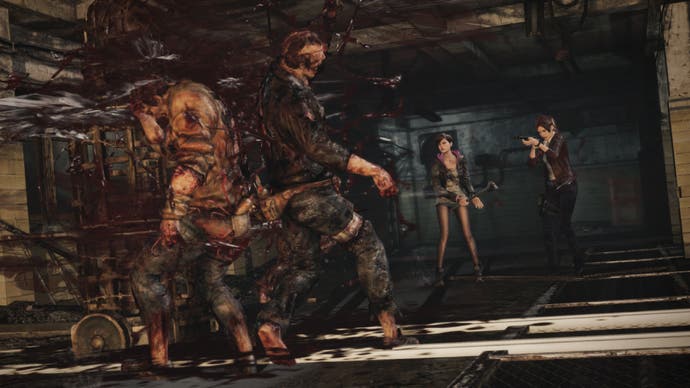
Putting all of the emphasis on one character to take down enemies is an unusual move, but it works for the most part because Revelations 2 tends to focus on smaller engagements over huge tear-ups. Acting as a distraction is more fun than it sounds, particularly with Moira, thanks to the new importance placed on dodging attacks. This mechanic was first seen in Resident Evil 3: Nemesis, and has reappeared subsequently, but Revelations 2 is the best implementation yet, dedicating a whole button to getting out of tight spots and alongside this making the enemy attack animations unpredictable in their timing. In previous Resident Evils, if a massive thing has you backed into a corner, there aren't many options - but here it's thrilling to duck out with perfect timing, and leave the monster flailing while your partner unloads.
The concept fits more neatly with Moira because she has both a crowbar, for melee attacks and ground finishers, and a flashlight for blinding enemies. With Natalia things are more ambiguous, though she works for me because the idea of being basically powerless in a survival horror environment is a great one. One of my favourite historical rumours, though I can't vouch for it, is that ex-Capcom man Yoshiki Okamoto once pitched for an Alone in the Dark reboot: you played as Carnby's grandmother trapped in the first game's mansion. Being an old woman she couldn't fight monsters, and so the game would have been about avoiding them and hiding at a slow pace. You can see why it didn't get made, but what a great idea.
Natalia has something of this. She's a little girl, and so entirely dependent on big boy Barry to protect her - and when you're briefly separated from him it's terrifying. At one point you need to find a brick so she can bash a padlock off a door that's blocking Barry, and I missed one that was hidden in some grass nearby. As I walked further and further into the pitch-black woodlands looking around, something growled in the distance. The silhouettes of trees began to look like monsters, I couldn't quite work out the direction I'd come from, and as my hands gripped the pad tighter I realised even running away would be difficult. Resident Evil has always done jump scares very well but this kind of fear is a much greater prize: nothing happened, it was all in my head. I eventually found a brick, went back, and switched controls to Barry with a wave of relief.
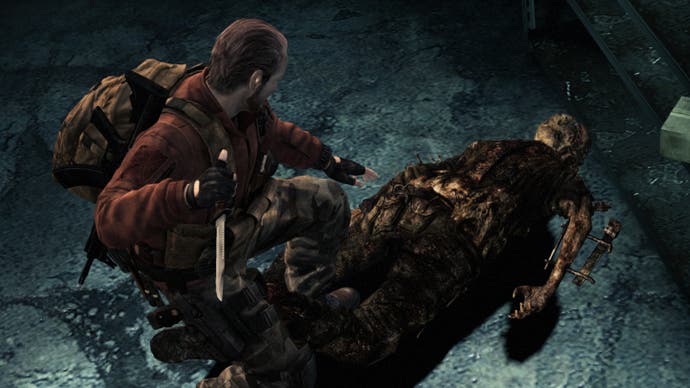
And no wonder, because Barry Burton is a beast. Part of Revelations 2's design is that, because Claire and Moira are a more capable pairing, they also face scarier monsters - the default zombie-things move faster, hit harder, and there are more occasions where the pair are swarmed. The default enemies in Barry and Natalia's sections are more traditional zombies, slower to react and close gaps, generally easier to take down, and rarely appearing in huge numbers. The weapon feedback is beautiful, with body hits jolting foes and headshots cartwheeling them backwards, and the enemies are equally hard-hitting and clever about dodging the line of fire. Start overconfident in your historical Resi skills, as I did, and within the first few minutes they'll rip you apart.
Part of this challenge, especially in the Claire section, is how dark the environments are. The penal colony is a gloomy place where your vision is only ever partial - at many points Moira's flashlight is as key as Claire's gun.
At first I found this smothering darkness annoying. It is annoying. But as you adjust to this new ruleset it becomes another part of why Revelations 2 feels like its own game. When enemies want to grab you, and it's hard to see very well, this breeds its own paranoia and gives otherwise unremarkable environments a thick atmosphere.
If there's a note Revelations 2 doesn't hit - and again this may change in future episodes - it is this fantastical side to Resi: the OTT environments, crazy puzzles involving body parts, and giant tentacled boss monsters. The absence of the latter, in particular, is keenly felt in this first installment: there are no bosses to speak of, and it really needs a big fight to cap everything off. The puzzles are poor, with no thinking required at any point, and the environments are basically a prison and a few cabins. There are compensations elsewhere, and I'm not saying Capcom should be smacking me with a Giant Bronze Midget Room from the off, but a little more flair wouldn't have gone amiss.
The final 'wait and see' caveat is for Raid mode, which at this stage seems to be outstanding but currently lacks online multiplayer. This matters enormously. Raid mode remixes environments and enemies into timed gauntlets, and levels everything up as your characters level up. I pumped countless hours into the original Revelations' Raid mode, but I did it all in co-op.
Revelations 2's structure is expanded, with much more emphasis on sweet loot drops and character customisation - and it also starts bringing in the enemy buffs much sooner. These buffs are the most fun thing about Raid mode: giant zombies, flaming zombies, superfast guys with electricity fields, hammer dudes with shields, all mixed in among the normal enemies. Levelling the player characters lets you apply active and passive skills, as well as equip weapons earned and bought, and after around 20 missions my Barry is a death machine of the first order. Raid mode does feel good but it simply doesn't feel right without online. This is a co-op mode that has to wait for the co-op option. Capcom only knows why.
The question Revelations 2 poses through stuff like this is why it's being released in the way it is. This doesn't feel like an episodic game, it feels like a game that's been portioned unnecessarily - and this in itself wouldn't bother me, except it has negatively affected the initial feature set, and down the line will reward people for waiting until the retail release to buy it. This is crazy.
Nevertheless, this should not overshadow the fact that the first episode of Revelations 2, on its own merits, does a lot of good things. It takes parts of Resident Evil history - Resi 2's Sherry, Resi 3's dodges, the 'Hook Man' Resi 4 flashlight mechanic, Resi 5's co-op - and brings them into the present day as a coherent whole. It focuses on mechanics like darkness and vulnerability that, arguably, couldn't or wouldn't be risked in a numbered entry. And Raid mode looks like the best implementation of this fantastic game type yet.
So we come back to the nature of a spin-off, and why Revelations 2 works. For me a spin-off has a responsibility to do different things, to take the core subject-matter and do something that for whatever reason the 'main' games can't. By these lights Revelations 2 is a good spin-off. But if you hold off for a month, it might yet turn out a great one.



